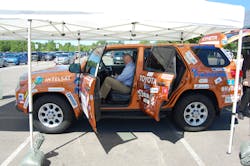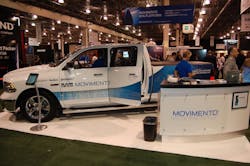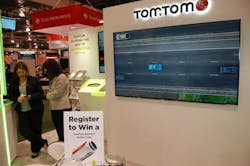NOVI, MI. A variety of “connected vehicle” technologies were on display at the 16th annual TU-Automotive Detroit 2016 Conference & Exhibition, held at the Suburban Collection Showplace in Novi, MI, located on the outer fringes of the Motor City.
Kymeta Corp. showed off its prototype mTenna satellite antenna system, packaged in the roof of a Toyota 4Runner SUV that’s traveled 20,000 miles across the U.S. over the last five months to demonstrate how such antennas can provide high-speed data access to every vehicle on the road.
“For connected cars, satellite connectivity will usher in new technologies and services, and broader market potential for automobile manufacturers,” noted Tom Freeman, senior vice president for land mobile at Kymeta.
“Technology needs to keep pace as demand from drivers and passengers for enhanced access to entertainment, services and data while on the road continues to grow exponentially,” he added. “By utilizing the excess satellite capacity, our antenna eliminates the bandwidth and geographic limitations of current LTE and terrestrial access solutions.”
Octo Telematics launched its new OCTO Fleet telematics package for insurance companies providing coverage both large and small North American fleets at the show.
OCTO Fleet Lite is a self-installed solution for commercial fleets comprised of light- and medium-duty units via OBD 2 ports, providing “data intelligence” previously reserved for larger organizations. Then there is OCTO Fleet, a professionally installed solution for commercial fleets comprised of heavy-duty units that cannot support OBD 2 ports. This package assesses driver behavior (idle time, braking and cornering habits, etc.) while offering anti-theft protection.
Octo new telematics packages also incorporate electronic logging device (ELD) capability as needed, to make its telematics system compliant by 2017 with the new ELD Final Rule.Over-the-air (OTA) automotive software and data management provider Movimento made two announcements at the TU-Automotive show. First it has forged a partnership with systems integration and infrastructure management services firm HCL Technologies Ltd., to offer automotive OEMs a “one-stop-shop” that covers everything from initial system integration to deployment, operations and customer support on a global basis for light vehicles.
"Auto OEMs have had a lot of headaches," explained Mahbubul Alam, chief technology officer and chief marketing officer for Movimento. "They don't have a single department or a group that is responsible for making everything come together on the software side for vehicles and what they've needed is a process from chip to car client to cloud solution for software that's part of their business operation.”
Movimento also has partnered up with digital security system provider Rambus Inc. to deliver “personalized” OTA vehicle updates critical to maintaining the security of the safety and performance systems within connected vehicles. Movimento’s OTA technology will use the Rambus CryptoManager platform, enabling in-field delivery of encrypted keys generated for each vehicle and allowing for secure communication between a vehicle and the cloud.
“As cars continue to increase in complexity and connectivity, often depending on more than 100 million lines of code to function, car makers and consumers alike are demanding simple and secure methods to download, authenticate and install vehicle updates,” said Movimento’s Alam. “The CryptoManager platform allows for cost reduction by enabling security features already embedded in automotive chipsets and requires no additional security hardware.”
A new generation of “wireless chargers” for connected vehicles made their debut at the TU-Automotive show, courtesy of Laird. “Wireless charging technology also can be combined with authentication, which opens up many more possibilities for use in the connected car,” explained Guido Dornbusch, Laird’s vice president of product management for connected vehicle solutions. “Some examples are using smartphones as a key, especially helpful for car sharing applications, or automated payment processes.”TomTom made several announcements at the show, the top one being coverage expansion for its high definition (HD) Map and RoadDNA products to 17 new states across the U.S. or more than an extra 33,500 miles of new HD Map interstate coverage.
“With over 75,800 miles of HD Map coverage globally, we’re equipping our automotive customers with the data needed to continue to push autonomous driving forward,” noted Willem Strijbosch, head of autonomous driving at TomTom. “The importance of having a map in the vehicle for autonomous driving is now widely accepted.”
TomTom has also been selected by Volvo Cars as the provider of location and navigation content and services for its new 2019 infotainment platform, which includes automotive-grade digital NDS Maps, incremental real-time map updates, and navigation software kits
TomTom also rolled out its new Localization Demonstrator at the show, which leverages its new HD Map and RoadDNA technology to provide lane-level “localization” for vehicles. Using sensors being designed for autonomous vehicles, the device with combine TomTom autonomous driving content with its correlation software to perform real-time lane positioning.
About the Author
Sean Kilcarr
Editor in Chief
Sean Kilcarr is a former longtime FleetOwner senior editor who wrote for the publication from 2000 to 2018. He served as editor-in-chief from 2017 to 2018.


